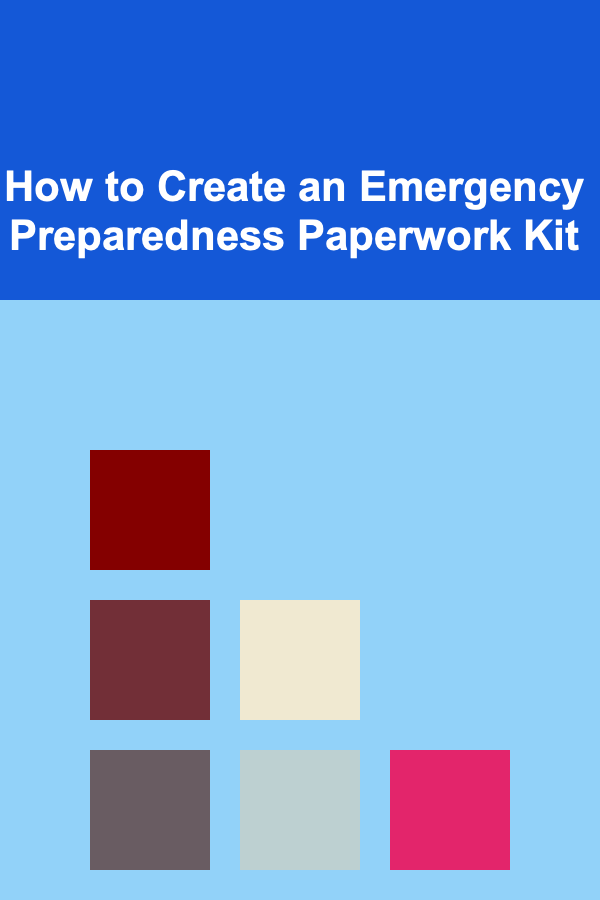
How to Create an Emergency Preparedness Paperwork Kit
ebook include PDF & Audio bundle (Micro Guide)
$12.99$8.99
Limited Time Offer! Order within the next:

In today's unpredictable world, being prepared for emergencies is essential. Whether it's a natural disaster, medical emergency, or unexpected event, having a well-organized paperwork kit can mean the difference between chaos and control. This guide will provide you with detailed steps on creating an emergency preparedness paperwork kit that ensures you have all the necessary information at your fingertips when you need it most.
Understanding the Importance of an Emergency Preparedness Paperwork Kit
A Sense of Security
An emergency preparedness paperwork kit provides peace of mind knowing that all critical information is organized and accessible during crises. In stressful situations, this readiness can significantly reduce anxiety.
Quick Access to Essential Information
Emergencies often necessitate immediate action. Having your documents readily available allows you to respond quickly without scrambling to find information in a panic.
Facilitating Communication
Essential documents facilitate communication with emergency services, family members, and shelters. They help ensure that everyone receives timely assistance without unnecessary delays.
Legal Protection
In some cases, having important legal documents ready---such as insurance policies and medical records---can protect your rights and interests during emergencies.
Types of Emergencies to Prepare For
Understanding the various emergencies that could affect you is crucial when preparing your paperwork kit.
Natural Disasters
- Hurricanes: High winds, flooding, and evacuations often accompany hurricanes.
- Earthquakes: Sudden and unpredictable, making preparedness essential.
- Flooding: Can occur due to heavy rains or storms, affecting homes and infrastructure.
Medical Emergencies
- Accidents: Injuries requiring immediate medical attention.
- Chronic Conditions: Managing medications and treatment plans during crises.
Man-Made Emergencies
- Fires: Home or wildfires pose threats to safety and property.
- Terrorism: Preparedness aids in navigating chaotic scenarios.
Essential Documents to Include in Your Kit
Identification Documents
- Government-issued IDs: Driver's licenses, passports, and state IDs.
- Social Security Cards: Important for identification and benefits.
Medical Records
- Vaccination Records: Required for pets and individuals, especially during outbreaks.
- Medical History: Summaries of chronic illnesses, allergies, and medications.
- Health Insurance Information: Policy numbers and contact details for providers.
Financial Documents
- Bank Account Information: Account numbers and online banking details.
- Insurance Policies: Homeowners, renters, health, and auto insurance documentation.
- Emergency Fund Details: Information regarding savings set aside for emergencies.
Emergency Contacts
- Family Members: Contact information for immediate family and close friends.
- Local Authorities: Numbers for local police, fire department, and emergency services.
Legal Documents
- Wills and Trusts: Ensure these are updated and easily accessible.
- Power of Attorney: Legal authority to make decisions on your behalf.
Important Miscellaneous Documents
- Pet Documentation: Includes vaccination records and ID tags.
- Employment Records: Pay stubs and employment letters for proof of income.
Organizing Your Emergency Preparedness Kit
Once you've gathered all necessary documents, organization is key.
Categorize Documents
- Identification: Group all identification-related documents together.
- Medical: Segregate medical records into another section.
- Financial: Keep all financial documents in a separate folder.
- Legal: Consolidate all legal documentation into one area.
- Emergency Contacts: Have a dedicated sheet or section for contacts.
Use Clear Labeling
Label folders clearly using large, bold fonts to make them easily identifiable. Consider using color-coded tabs for faster access.
Use Protective Covers
Store sensitive documents in protective plastic covers to prevent damage from spills or tears. This is particularly useful for documents that may need to be presented during emergencies.
Creating a Family Communication Plan
A comprehensive communication plan is vital during emergencies.
Establish Primary Contacts
Identify who the primary contacts are for each family member. This can include:
- Spouses
- Parents
- Designated friends or relatives
Develop Meeting Points
Outline safe meeting points, both near home and farther away, in case evacuation is necessary.
Share Information
Disseminate contact information among family members. Everyone should know where to find essential documents and how to reach each other.
Storing Your Emergency Preparedness Paperwork Kit
The storage location of your paperwork kit is just as important as its content.
Choose a Safe Location
Select a location that is easily accessible but also secure. This could be:
- A fireproof safe
- A locked drawer
- A designated box in your home emergency kit
Maintain Visibility
Ensure that everyone in your household knows where the kit is stored. It should be easy to locate amidst a crisis.
Consider Portable Options
For those who may need to evacuate, consider keeping a smaller version of your paperwork kit in a portable, waterproof container. This kit should contain the most essential documents for quick access.
Regular Maintenance and Updates
Your emergency preparedness paperwork kit is not a "set it and forget it" project.
Schedule Regular Reviews
Set aside time every six months to review your kit. During this review, check for:
- Expired documents
- Changes in personal circumstances (new family members, moves, etc.)
- Updated healthcare information
Utilize a Checklist
Create a checklist of items to verify during each review. This helps keep your maintenance consistent and thorough.
Digital Copies and Backups
While physical documents are essential, digital copies serve as a valuable backup.
Create Scans of Important Documents
Use a scanner or mobile app to create digital versions of all critical documents. Save them securely in a cloud storage service.
Organize Digital Files
Maintain a similar organizational structure in your digital files as you do in your physical kit. Use folders labeled with categories like "Identification," "Medical," and "Financial."
Share Access
Consider sharing access to important digital files with trusted family members. This way, they can assist you if you're unavailable.
Educating Your Family Members
Preparedness is more effective when everyone is involved.
Conduct Training Sessions
Hold family meetings to discuss the importance of the emergency paperwork kit. Explain how to use it and what to do in case of an emergency.
Practice Drills
Run through emergency drills that incorporate accessing the paperwork kit. Simulating real-life situations can increase confidence and preparedness.
Encourage Questions
Create an open environment for questions about the kit and emergency procedures. Address any concerns family members may have.
Common Challenges and Solutions
Challenge: Forgetting to Update Documents
Solution: Set reminders in your calendar to review the kit regularly. Make it a seasonal task, like spring cleaning.
Challenge: Losing Track of Digital Documents
Solution: Create a master list of all digital files, including their locations in cloud storage. Regularly update this list.
Challenge: Confusion During Emergencies
Solution: Use clear labeling and simple organization methods to minimize confusion. The simpler the system, the easier it is to navigate under stress.
Case Studies: Successful Emergency Preparedness
Case Study 1: Family in Hurricane-Prone Area
Context: A family living in a hurricane-prone area faced multiple evacuations.
Solution: They created an emergency paperwork kit that included evacuation plans, medical records, and insurance policies. They practiced drills and ensured everyone knew the kit's location.
Outcome: During their next hurricane warning, the family evacuated efficiently, having all necessary information readily accessible. They were able to file claims promptly after the storm, mitigating financial loss.
Case Study 2: Individual with Chronic Illness
Context: A person with chronic health issues needed to ensure that medical information was readily available during emergencies.
Solution: The individual compiled a comprehensive emergency kit containing medications, medical history, and emergency contacts. They stored both physical and digital copies.
Outcome: When faced with a sudden medical crisis, the individual accessed their kit quickly, enabling healthcare providers to deliver appropriate care without delay.
Conclusion
Creating an emergency preparedness paperwork kit is a proactive step toward safeguarding yourself and your loved ones in times of crisis. By understanding the types of emergencies, gathering essential documents, organizing your kit effectively, and regularly maintaining it, you can ensure you are prepared for the unexpected.
Take the time to educate your family members and practice your emergency plans. With a well-structured paperwork kit, you can navigate emergencies with confidence and ease, knowing that you are ready for whatever comes your way.
Reading More From Our Other Websites
- [Organization Tip 101] How to Organize Yarn by Color and Weight
- [Star Gazing Tip 101] Star-Crossed Getaways: Combining Cozy Cabins and Night Sky Wonders for Romance
- [Screen Printing Tip 101] How to Design and Print QR‑Code Embedded Artwork for Interactive Apparel
- [Home Renovating 101] How to Create a Renovation Budget That Works
- [Organization Tip 101] How to Keep Craft Kits for Different Projects Separate
- [Sewing Tip 101] How to Design and Sew a Convertible Backpack‑to‑Tote Bag
- [Personal Care Tips 101] How to Find Affordable Drugstore Skincare That Works
- [Home Space Saving 101] How to Design a Space-Saving Laundry Area in a Small Apartment
- [Home Rental Property 101] How to Create a Pet Policy for Your Rental Property That Works
- [Home Lighting 101] How to Light Outdoor Spaces with Solar Power: A Comprehensive Guide

How To Avoid Distractions When Working Remotely
Read More
How to Deal with Difficult Tenants in Your Home Rental Property
Read More
How to Store Your Sports Equipment in an Organized and Accessible Way
Read More
How to Understand Sharding in Blockchain
Read More
Finding Challenging Hiking Trails: A Comprehensive Guide
Read More
Creating a Feng Shui Vision Board for Your Goals
Read MoreOther Products

How To Avoid Distractions When Working Remotely
Read More
How to Deal with Difficult Tenants in Your Home Rental Property
Read More
How to Store Your Sports Equipment in an Organized and Accessible Way
Read More
How to Understand Sharding in Blockchain
Read More
Finding Challenging Hiking Trails: A Comprehensive Guide
Read More